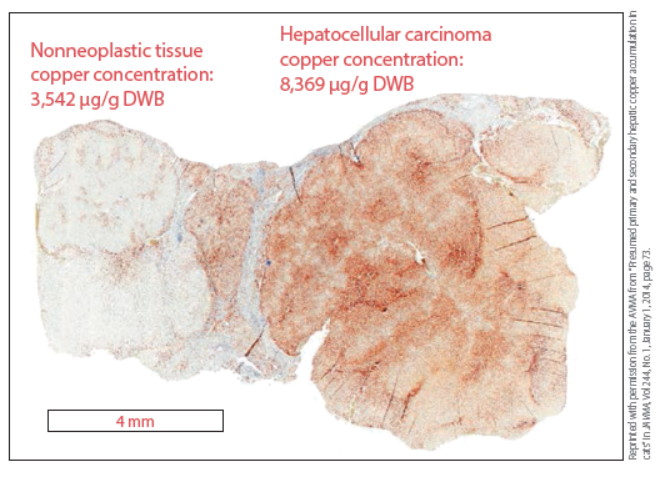Copper is an essential nutrient in a cat’s diet. It is critical for the formation of collagen and bone, the absorption of iron (another essential nutrient), and the formation of melanin that gives fur its pigment. It also acts like an antioxidant in the body, scavenging free radicals that can harm cells, and is necessary for reproduction. But some cats accumulate too much copper in their livers. It’s not that they ingest too much with their diets. It’s that their bodies malfunction and don’t properly get rid of it. In those cases, copper becomes toxic, causing everything from vomiting and lethargy to jaundice, weight loss, abdominal distention, and, if the excess goes unchecked long enough, death.
“Copper accumulation in the livers of cats has only recently been recognized,” says Tufts veterinary internist Michael Stone, DVM. “It is routinely tested for in dogs.” While thought to be more rare in cats than dogs, it is still important to consider that it might be the culprit when a cat is failing with the above mentioned constellation of symptoms.
Two reasons for excess copper
Some cats are born with an inability to properly rid their livers of excess copper; it is a congenital defect with no other underlying cause and is therefore called primary liver disease. In such cases, a cat will have copper concentrations in the liver that are as much as 10 times higher than normal and will generally become sick by the time they are two years old.
More often, however, the copper build-up occurs because of some other disease of the liver that is not allowing for proper copper metabolism. This is called secondary liver disease because the copper accumulation is secondary to another condition. The other condition could be obstruction of the bile ducts that lead from the liver to the gallbladder or inflammation, infection, or cancer of the liver. If the disease can be effectively tended to, the excess accumulation of copper will begin to correct itself, although it still may be necessary to “pull out ” the excess copper that has already built up.
“Secondary copper disease is much more common in cats,” Dr. Stone says. It tends to get picked up later in life, and copper levels are generally not as high. According to a study of more than 100 cats that appeared in the Journal of the American Veterinary Medical Association, cats whose copper build-up occurs because of another disease average about 200 to 300 micrograms of copper per gram of liver, as opposed to more than 1,800 for cats with primary copper disease. (A healthy number is anything below 180).
A proper diagnosis
The first thing a veterinarian might check when he suspects excess copper accumulation is blood levels of certain liver enzymes. If they are high, he will probe further.
The way to test definitively for copper content is by biopsying the liver. Sometimes this can be done with a needle biopsy. But usually surgery, either traditional or laparoscopic, is necessary to get a large enough liver sample.
Once the liver cells are extracted, a pathologist examines them under a microscope to check copper content. “No currently available blood test or imaging exam will specifically diagnose copper build-up in the liver,” Dr. Stone says. “It can be suggestive, but a biopsy is needed.”
Treatment protocol
Treatment consists of medications, a change in diet, or commonly, both. Some medications act as chelating agents, meaning they pull heavy metals from the system.
There are also therapeutic, low-copper diets that can be prescribed for cats over the long haul by a veterinarian for cases in which copper accumulation is a primary disease or the result of a secondary disease causing copper build-up that cannot be adequately controlled. A veterinary internist might work with a veterinary nutritionist to determine the right diet in combination with the right drugs.
The good news is that once excess copper build-up is identified, solutions are at hand.





Widgit our 6 year old has stopped urinating Vet advised to stop all foods except for Hills diet dry food. what do u suggest please
Stop dry food and replace with raw immediately – adding appropriate vitamins and minerals either in a complete supplement or a prescribed diy as advised by an animal nutritionist